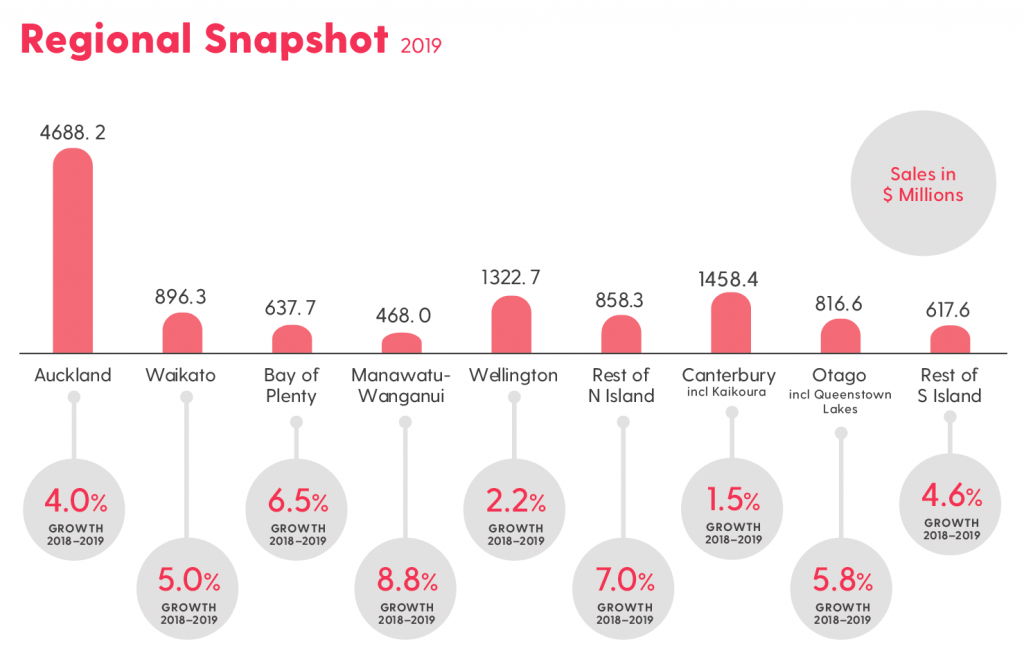The Restaurant Association have released the 2019 Hospitality Report, providing topline statistics on the hospitality industry. The report research includes information on industry sales, industry employee data, the number of businesses, regional and sector outlooks and more. It also highlights the key challenges for the industry and for the first time includes new research outlining consumer dining insights.
Highlights:
- Nationwide sales for the hospitality industry in 2019 (year end March) increased by 4.2 per cent, to reach $11.7 billion.
- Sales growth in 2019 carried across all sectors, excluding the clubs sector, with the dominant restaurant and café sector recording the highest growth of 5.1 per cent.
- Regionally, revenue growth in Kaikoura was highest, at 21.2 per cent, as the region continues it’s recovery from the earthquake at the end of 2016. The Taranaki region also recorded a strong 10.8 per cent growth in sales.
- The number of hospitality businesses nationwide increased by 480 in total to reach 17,895 in 2018.
- The industry currently employs over 133,000 people.
The latest Restaurant Association Hospitality Report finds that nationwide sales for the hospitality industry have continued to grow, with the restaurant and café sector recording the highest growth at 5.2 per cent.
In 2019 New Zealand’s hospitality sector achieved record sales of over $11.7 billion (year end March 2019). This represents sales growth of 4.2 per cent over the previous year, which follows two years of significant growth (3.6 per cent from 2017-2019 and 8.2 per cent from 2016-2017).
Sales growth carried across the industry, excluding the clubs sector, with restaurants and cafes recording the highest sales increase. Over half of every dollar spent dining out is spent at a restaurant or café, which has almost 51 per cent market share.
Annual sales for this dominant sector grew 5.1 per cent in 2019, which in dollar terms translates to an increase over the year previous of $290 million. Pubs, taverns and bars also realised annual sales growth of 4.9 per cent (an increase of $79 million) and catering services grew by 4.5 per cent ($39.7 million). Takeaway / food to go sales growth has led the industry over the past 3 years but that growth slowed in 2019. This sector achieved a 2.6 per cent annual sales increase in 2019.
Regional outlook
Consumer spending is highest in Auckland, Wellington and Canterbury. These three regions all have annual sales of more than $1 billion per annum. The Waikato region has also seen sales growth of 31 per cent over the past 5 years and now records annual sales of almost $900 million, reaching closer to achieving the $1 billion threshold.
Regionally, the largest percentage sales increases from 2018 – 2019 were in Kaikoura (up 21.2 per cent in 2019), Taranaki (up 10.8 per cent), and the Nelson region (up 10.3 per cent). All regions across the country recorded sales growth, with Canterbury (excluding Kaikoura) recording the smallest growth for the year (up 1.3 per cent).
From 2017–2018, the hospitality industry grew by 2300 employees to reach 133,100. In line with MBIE projections, this represents growth of 1.8 per cent. This is the smallest industry employment growth since 2013 (when growth was 1.7 per cent), no doubt impacted by the challenges operators have finding skilled staff.

Dining out trends research highlights great food and service as key to memorable dining experiences
The Restaurant Association’s 2019 Great Dining Out Survey gives an insight to the eating out habits of the New Zealand consumer. Responses were collated from around 1,000 customers, who revealed that eating out isn’t just for special occasions any more. Our busy lifestyles are encouraging consumers to turn away from their kitchens at mealtimes, where instead restaurants and cafes are having a critical role in feeding us regularly.
- 45 per cent of the dining out survey respondents eat out 1-3 times per week.
- Dinner and lunch are the meals that respondents most commonly eat away from home.
- 48 per cent say their most frequent dining out occasion is for causal dinner dining.
- Dining out over the daytime is also popular, with 28 per cent of the survey respondents saying they dine out for lunch most frequently.
- While 44 per cent of diners like to choose somewhere that they have been before and they know is good, 35 per cent want to try something new, and choosing a place that they have never been to before is important.
- If you want to deliver a memorable dining out experience, great food is the most important factor for diners, closely followed by great service. Good value for money is again also important.
- When dining experiences are memorable for the wrong reasons, poor service is the top ranked issue. Long waiting times also rankle, along with poor value for money and dirty plates or cutlery.
- When it comes to food to go, 42 per cent indicate that they order food to take away (pick up or home delivery) 1-3 times per week, with 38 per cent restricting takeout to once or twice per month.
When choosing where to dine, the food and menu have the biggest influence on consumers. However, many consumers are also looking for good value for money, making this another important decision-making factor. To deliver a memorable dining out experience to customers, great food is the most important factor for diners, closely followed by great service.
Key challenges
The rate of growth in hospitality over the past five years has been impressive and the industry is booming. However, to offer stability in a period of rapid growth it is important that the industry has the foundations to manage its challenges to remove any barriers and maximise opportunities for success.
Hospitality business owners cite the lack of skilled employees, managing wage costs, government legislation and compliance, building and maintaining sales volume and managing the tax burden as their five biggest challenges.
This competition for skilled employees has the potential to drive wage rises in some regions, although operators also look for creative ways to retain employees to ensure their labour costs are kept under control. Wages continue to rise beyond customers’ expectation of price rises and that’s a challenge and balancing act that hospitality business owners face.
We are looking at some significant Government policy changes in the coming 12-18 months, covering employment, immigration, education and more. This is affecting business confidence in our sector, which lists Government legislation and compliance as the fourth top challenge.
“The hospitality industry has performed exceptionally well over recent years in light of economic uncertainty, legislation changes, rising costs and increased compliance obligations.” Says Marisa Bidois, CEO of the Restaurant Association
“For business owners there are challenges to achieving profitability, as the volume of new businesses sees consumer spend split across more operations. However, the industry is in a stable position, continuing to grow in sales, outlet and employee numbers. Hospitality operators are by nature optimistic and hospitality will continue to serve up opportunities for success for those operators offering a consistent product that resonates with their customers.”

Restaurant Association members can download the full free electronic copy of the 2019 Hospitality Report online in the Shop.
If you are not a member of the Restaurant Association, the 2019 Hospitality Report is available for purchase to the wider industry for $150.00 +gst.
